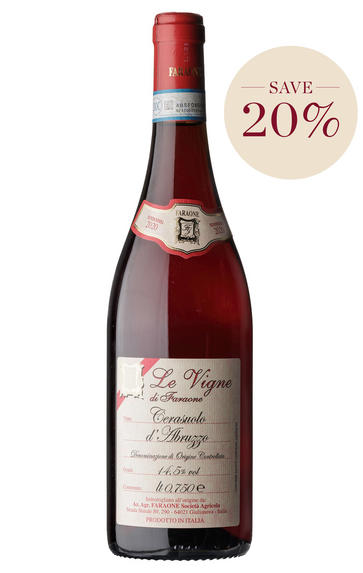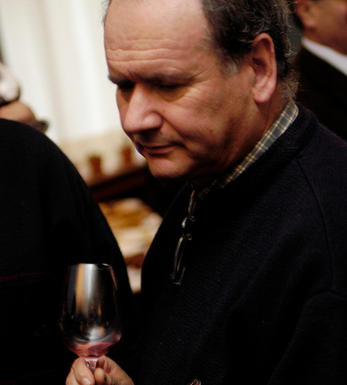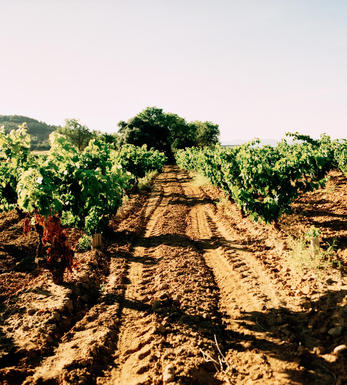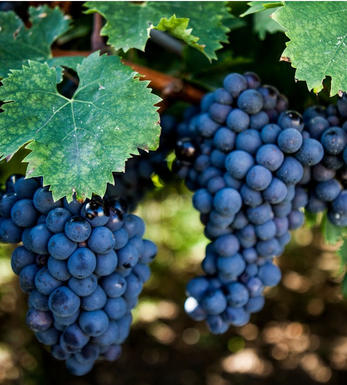
2022 Le Vigne, Montepulciano, Cerasuolo d'Abruzzo, Faraone, Italy

About this WINE

Faraone, Abruzzo
The Faraone family produces traditional Montepulciano d’Abruzzo wines. Their 9ha property is now focused on the new ‘Collepietro’ vineyard at Mosciano Sant’Angelo in the Colline Teramane DOCG zone of Abruzzo, some 10 miles from the Adriatic.
Faraone’s story dates back to 1916, and particularly to the 1930s when Montepulciano, Sangiovese and Passerina were first planted; bottling started in 1970. Giovanni Faraone makes the wine, aided by his wife Paola & sons Alfonso & Federico; the latter an oenologist who’s worked in France and New Zealand before taking up a post in Umbria. They also make a fine Trebbiano d’Abruzzo, Passerina and Pecorino.

Abruzzo
Abruzzi (Abruzzo) is an eastern Italian province. Although it remains insignificant in terms of the fine wine market, it is important quantitatively, drawing most of its wine production from the Montepulciano d'Abruzzo grape.
Since 2003 there’s been a rash of new, grape growers-turned bottlers, spurred on by the region’s first DOCG Montepulciano d’Abruzzo Colline Teramane, but it’s clear that many lack the knowhow/heritage to do this professionally or they’re hiring in expensive consultants to fast-forward/pay off the bank loan, often ending up with boringly international, overly technical wines (while still keeping a large foot in the bulk market).
There is a definite move back to autochthonous grapes as producers grapple with climate change, believing, as others in Italy, that these grapes are better equipped to deal with the meteorological extremes. According to Valentini, the traditional high tendone/pergola abruzzese form of trellising seems better placed to cope with these hotter climes, shielding the fruit and supporting acidities (echoed in Valpolicella by Monte dei Ragni).
Black Montepulciano d’Abruzzo (aka Cordisco) is a ‘noble’ grape with a history back to 1793, whose origins lie in the Valle Peligna of the Apennines, to the town of Sulmona. Purple coloured, packed with flesh, low-medium tannins but inclined to give reduced gamey wines it’s the workhorse of the bulk wine industry, distributed as blending wine everywhere in Italy (and Europe?); the DOC can be blended with 15% other abruzzese grapes.
White Trebbiano d’Abruzzo dates back to 16th century but its identity is frequently confused with Trebbiano di Toscana, Trebbiano di Romagna and Trebbiano di Soave! DOC allows blending with 15% local white varieties (e.g. Chardonnay, Fiano, Bombino – from Puglia!) Mostly overcropped to give insipid ‘sweet water’ wines of low alcohol, light body, grassy almond notes, yet potentially very good if treated with respect, without irrigation and on VSP trellising.
Autochthonous white Passerina, Pecorino, Cococciola varieties have become fashionable, giving wines with more obvious personality at high yields (than Trebbiano). Cerasuolo d’Abruzzo rosato is making a comeback too. From being the wine the pescatori (fishermen) it has since become a more serious proposition, probably due to its production from salasso/saignee/bleeding the MdA vats giving wines with greater body and abv%. It may prove to be the perfect ‘rosato’ in future, ideal wine style for any Asian dish.
David Berry Green, Wine Buyer
Recomended Producers: Col del Mondo, Cirelli, Faraone, Valentini

Montepulciano
The Montepulciano grape stands as a cornerstone of Italian viticulture, flourishing in Central and Eastern Italy. Despite its name, it maintains no genetic ties to the renowned Tuscan town of Montepulciano nor its celebrated Vino Nobile di Montepulciano, which predominantly features Sangiovese. Renowned for its adaptability, Montepulciano thrives in a spectrum of soil types and climates. Exhibiting robust growth characteristics, it yields generously and matures late in the season, offering winemakers flexibility in cultivation and harvest.
The heartland of Montepulciano lies in the Abruzzo district, where its flagship incarnation, Montepulciano d'Abruzzo, reigns supreme. Here, it delivers wines of remarkable character and distinction. In the Marche region, it harmonises with Sangiovese to craft illustrious blends such as Rosso Conero and Rosso Piceno, showcasing its versatility and capacity for nuanced expression.
Montepulciano wines typically embody a light to medium-bodied profile, brimming with fruit-forward flavours. Often characterised by gentle tannins and moderate acidity, they offer immediate pleasure and accessibility, best enjoyed in their youth. Yet, a select cadre of visionary producers employs low-yielding old vines, crafting 100% Montepulciano wines that undergo meticulous oak ageing. These esteemed bottlings defy convention, evolving gracefully in the bottle over a decade or more, unfurling layers of complexity and refinement.


Buying options
Add to wishlist
Description
The price of the 75cl bottle, reduced from £19.50 previously, includes a 20% discount. This offer is valid until stocks last and does not apply to BBX listings.
Cerasuolo is Italy’s most renowned rosé, but it rarely makes it out of Abruzzo such is the local demand. This is one of the region’s finest examples, organically grown by Federico Faraone from a traditional pergola vineyard planted in 1981. The skins macerate for one night with the juice, giving a vibrant, cherry-like hue. This is followed by a slow, cold, 10-day fermentation.
The nose is enticing: Pinot-esque, with wild, musky perfume and explosive berry-fruit charm. The palate bridges a style between rosé and light reds - a historical style which is now alla moda. Crunchy, tangy and dangerously moreish, enjoy this with sunshine and grilled tuna steaks.
Drink now
Davy Żyw, Senior Buyer, Berry Bros. & Rudd
wine at a glance
Delivery and quality guarantee